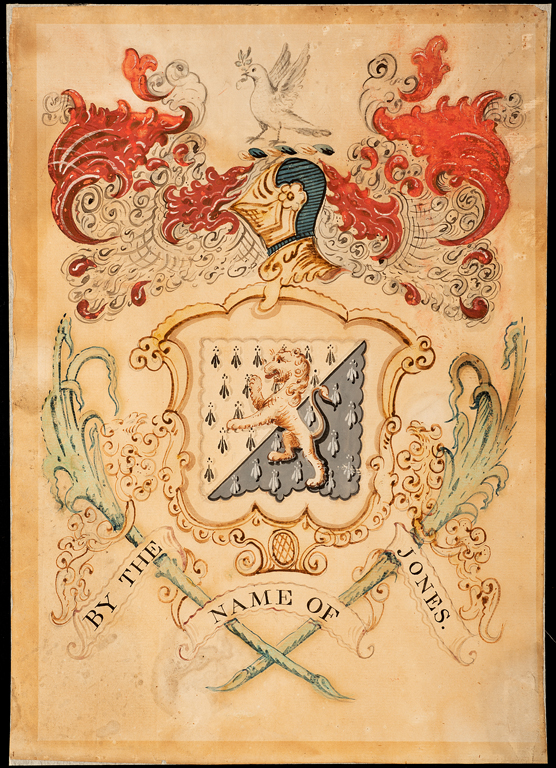| Maker(s): | Coles, John, Sr. (attributed); Coles Jr., John (attributed) | | Culture: | American (c.1749-1809) (1776-1854)
| | Title: | coat of arms: By the Name of Jones
| | Date Made: | circa 1800
| | Type: | Drawing
| | Materials: | watercolor, ink, paper, wood, glass
| | Place Made: | United States; Massachusetts; Boston
| | Measurements: | Frame: 15 1/2 x 11 1/16 x 1 in; 39.4 x 28.1 x 2.5 cm; Sheet: 13 3/4 x 9 11/16 in; 34.9 x 24.6 cm
| | Accession Number: | HD 2431.1
| | Credit Line: | Gift of Mr. and Mrs. R.W. Jones
| | Museum Collection: | Historic Deerfield
|
|

|
Description:
Framed coat of arms titled "BY THE NAME OF JONES" done in watercolor, pen and ink on paper, which is attributed to John Coles Sr. (c.1749-1809) or to his son John Coles, Jr. (1776-1854). Coles was first listed in the Boston Directory as a publisher and painter in 1782, the year he published John Norman's engravings of portraits of George and Martha Washington based on Benjamin Blyth copies. In 1776, John Hancock (1737-1793) commissioned Charles Willson Peale (1741-1827) to paint these portraits, which may have been taken to Boston in 1777 for safety. Benjamin Blyth could have made copies of these then or from copies made by John Trumball (1756-1843) in 1777. In 1788, Coles was listed as a painter and as a heraldry painter in 1796, which listing continued through 1813; he owed and probably used as his design source a 1724 edition of John Guillim's, "Display of Heraldry." His son, John Coles Jr. (1776-1854), also a portrait, miniature and heraldic painter, was listed in the Boston city directories from 1803 to 1825, and later lived in Providence; had a winter studio in Hartford and summer home in Durham, Connecticut, from 1831-1848; and in Worcester. See also coats of arms, "By the Name of Russell" (HD 71.105); "By the Name of Hurd" (HD 2431.2), and "By the Name of Williams" (HD 2009.32), attributed to John Coles, Sr.
Label Text:
Throughout the 18th century Americans maintained the English aristocratic tradition of prominently displaying their family coat of arms in their homes. This painting of the arms of the Jones family is similar to numerous examples executed by John Coles, Sr., a Boston heraldry painter. Coles characteristically placed the name of the family in the scrolls beneath the shield, a location more commonly reserved for a motto. The crossed green branches, closed helmet, and standard size of paper are also typical of Coles's work.
Subjects:
Watercolor painting; Glass Link to share this object record:
https://museums.fivecolleges.edu/detail.php?t=objects&type=ext&id_number=HD+2431.1 |